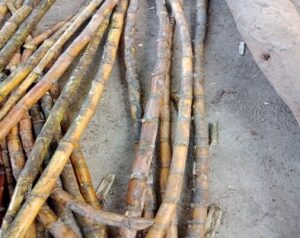Sugarcane is a traditional crop of the indigenous people of Kayan, Tadian, Mountain Province. This tall perennial crop can store a high concentration of sugar in its stem which is extracted by the locals to produce “inti” or “inakob” (sweeteners) and “basi” or sugarcane wine.
In the past, Barangay Kayan has little to no production of sugarcane. Gannapong is the oldest variety in the community with a soft stem that is easily crushed even with bare hands. Its stem characteristic makes it time-consuming and laborious for the community to extract its juice using a sugarcane presser. It easily breaks which requires a continuous and cautious feeding of sugarcane to the machine. In extracting, the fibers go along with the juice that needs to be screened thoroughly. The community never tried to process this sugarcane into muscovado because of these reasons. This is grown mainly for raw juice consumption so it is planted by a few and in small quantities.
The community members relied on commercial sugar for household needs. In 2010, the Kayan Unity for Development Organization (KUDO) a multi-sectoral organization based in the locality launched a campaign for sugarcane production. Unknowingly, it contributed to the introduction of other varieties in the community.
Due to the skyrocketing prices of commercial sugar in recent years and the increasing sugarcane production, the KUDO members decided to produce their sugar after being trained on muscovado processing with the help of CorDisRDS. To identify the best variety for the purpose, the organization documented the properties of the five dominant varieties in the community based on the land suitability criteria through side-by-side trials.

A traditional variety locally called awilan produces more kilograms of muscovado.
The sugarcane in Kayan which is the subject of the trial are awilan and eda both traditional varieties in Mountain Province which originated from Besao, while tresi, katorse, and kinsi are introduced varieties from the neighboring provinces. Awilan has violet skin and can reach a diameter of one to two inches when fully grown. Eda has greenish skin with a smaller diameter of one to one and a half inches. The new varieties have yellowish skin and are larger compared with the old varieties with their stem having a diameter range of two to four inches.

The introduced varieties in the community called tresi, katorse, and kinsi
It was observed that based on the optimum quantity of all sugarcane varieties planted in a per unit area, the traditional varieties produced a low volume of juice but produced the highest muscovado compared with the introduced varieties when planted across geographical locations either on top of a mountain or in low-lying areas. The finished product as documented by the organization revealed that 12 cans of traditional sugarcane juice yielded 42 kilograms of muscovado while 12 cans of the introduced variety produced 29 kilograms of sugar.
Furthermore, the traditional varieties are resistant to rat attacks given the hardiness of their skin, unlike the introduced varieties which have softer skin and are preyed on by rats resulting in huge losses in production.
In muscovado processing, traditional varieties are more practical in terms of time and labor. The time and labor spent in cooking for the old varieties are shorter compared to the introduced ones. The organization documented that it takes 4-5 hours for the traditional varieties to process while introduced varieties would take 6 hours to process the sugar.
With the organization’s experiences and observations from growing sugarcane to processing muscovado, KUDO found out the best varieties to optimize production and do away with the pricey commercial sugar while providing a low-cost yet very nutritious sugar to the local households all-year round. Traditional varieties are suited for this because they have more sugar content and are rat resistant due to the hardiness of its stem.
To produce a quality muscovado, KUDO recommends that the best location to grow sugarcane is in an area exposed to sunlight. The organization observed that sugarcane exposed to sunlight the whole day produces more volume of muscovado with the fine quality compared to those planted in a waterlogged area that produces juice that could hardly crystallize.
In the same manner, they also encourage the propagation of the gannapong to preserve the oldest variety and to try processing this variety into muscovado in the coming years.
